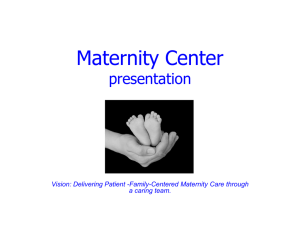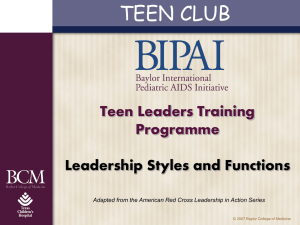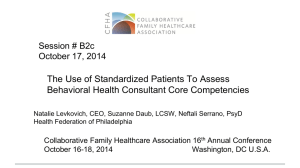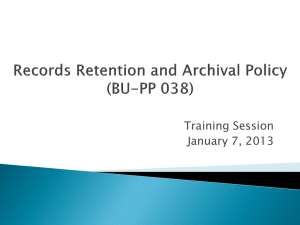ISQUA Webinar_March 2014_David Ballard
advertisement
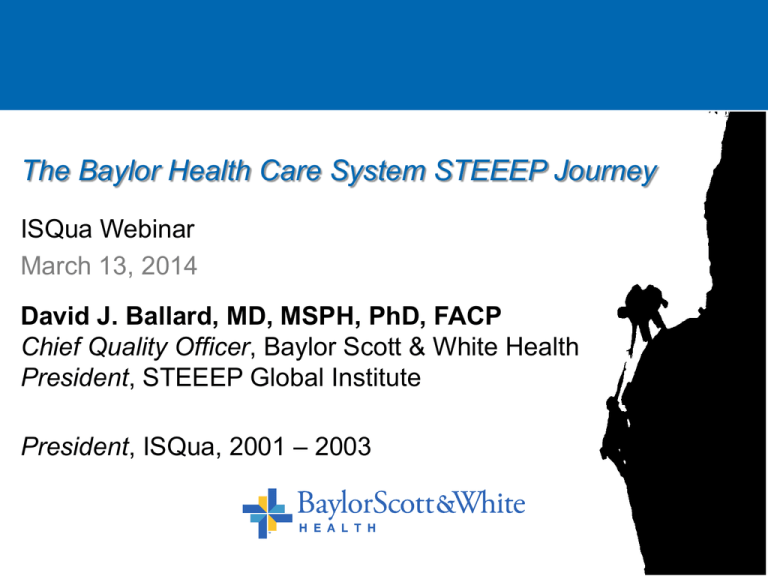
The Baylor Health Care System STEEEP Journey ISQua Webinar March 13, 2014 David J. Ballard, MD, MSPH, PhD, FACP Chief Quality Officer, Baylor Scott & White Health President, STEEEP Global Institute President, ISQua, 2001 – 2003 Topics to be Covered 1. 2. 3. 4. Overview of Baylor Scott & White Health Defining STEEEP Care and the STEEEP Journey International Quality Frameworks System Alignment for STEEEP Care Governance Organization Leadership Accountability: Goal Setting & Incentives 5. Infrastructure and Tools for STEEEP Care STEEEP Academy Electronic Health Records STEEEP Measurement, Analytics, and Reporting 6. Achieving STEEEP Health Care: An Example 7. Concluding Remarks 1 Overview of Baylor Health Care System More than 300 access points of care including: 30 hospitals owned, operated, joint-ventured or affiliated with BHCS 28 ambulatory surgery/endoscopy centers 209 locations for the HealthTexas Provider Network (the BHCSaffiliated ambulatory care physician network) 91 satellite outpatient facilities for imaging, rehabilitation, and pain 3 senior health centers 6 retail pharmacies 3 Baylor Research Institute locations 1 accountable care organization (Baylor Quality Alliance) Merged with Scott & White Healthcare on September 30, 2013 to form the largest not-for-profit health care system in Texas . . . 2 The New Baylor Scott & White Health More than 500 patient care sites including 43 hospitals 5.3 million patient encounters annually More than 34,000 employees More than 6,000 affiliated physicians Scott & White health plan $8.3 billion in total assets $5.8 billion in total net operating revenue 3 Topics to be Covered 1. 2. 3. 4. Overview of Baylor Scott & White Health Defining STEEEP Care and the STEEEP Journey International Quality Frameworks System Alignment for STEEEP Care Governance Organization Leadership Accountability: Goal Setting & Incentives 5. Infrastructure and Tools for STEEEP Care STEEEP Academy Electronic Health Records STEEEP Measurement, Analytics, and Reporting 6. Achieving STEEEP Health Care: An Example 7. Concluding Remarks 5 Crossing the Quality Chasm (Institute of Medicine, United States, 2001) The nation’s health care delivery system has fallen far short in its ability to translate knowledge into practice and to apply new technology safely and appropriately Overly devoted to dealing with acute, episodic care needs and lacking the multidisciplinary infrastructure required to provide the full complement of services needed by people with common chronic conditions Delivery of care often is overly complex and uncoordinated, requiring steps and patient “handoffs” that slow down care and decrease rather than improve safety Bringing state-of-the-art care to all Americans in every community will require a fundamental, sweeping redesign of the entire health system… 5 U.S. Institute Of Medicine Six Aims for Improvement, 2001 Safe Avoids injuries to patients from care that is intended to help them Timely Reduces waits and harmful delays impacting smooth delivery of care Effective Provides services based on scientific knowledge to all who could benefit & refrains from providing services to those not likely to benefit (avoids overuse & underuse) Efficient Uses resources to achieve best value by reducing waste, production, and administration costs Equitable Does not vary in quality according to personal characteristics such as gender, income, ethnicity & location Patient Centered Respectful of and responsive to individual patient preferences, needs, and values 6 Baylor Health Care System’s STEEEP Journey The STEEEP acronym was trademarked by BHCS to communicate the challenge of achieving its objective to provide ideal care in terms of the IOM’s call for care that is safe, timely, effective, efficient, equitable, and patientcentered. STEEEP also communicates the “steep” challenge of ascending from current levels of care to achieving the national Triple Aim (articulated by Don Berwick in 2008) of better care for individuals, better health for populations, and reduction in per-capita health care costs. 7 Topics to be Covered 1. 2. 3. 4. Overview of Baylor Scott & White Health Defining STEEEP Care and the STEEEP Journey International Quality Frameworks System Alignment for STEEEP Care Governance Organization Leadership Accountability: Goal Setting & Incentives 5. Infrastructure and Tools for STEEEP Care STEEEP Academy Electronic Health Records STEEEP Measurement, Analytics, and Reporting 6. Achieving STEEEP Health Care: An Example 7. Concluding Remarks 9 International Quality Frameworks: United States National Quality Strategy (2011) Three aims Six priorities Better care Healthy people/healthy communities Affordable care Making care safer by reducing harm caused in the delivery of care. Ensuring that each person and family are engaged as partners in their care Promoting effective communication and coordination of care. Promoting the most effective prevention and treatment practices for the leading causes of mortality, starting with cardiovascular disease. Working with communities to promote wide use of best practices to enable healthy living Making quality care more affordable for individuals, families, employers, and governments by developing and spreading new health care delivery models. 9 International Quality Frameworks: Australia Australian Safety and Quality Framework for Health Care (2010) Safe, high quality health is always: Consumer centered • Providing care that is easy for patients to get when they need it. • Making sure that healthcare staff respect and respond to patient choices, needs and values. • Forming partnerships between patients, their family, carers and healthcare providers. Driven by information • Using up-to-date knowledge and evidence to guide decisions about care. • Safety and quality data are collected, analysed and fed back for improvement. • Taking action to improve patients’ experiences. Organised for safety • Making safety a central feature of how healthcare facilities are run, how staff work and how funding is organised 10 International Quality Frameworks: Norway National Strategy for Quality Improvement for the Health and Care Services, 2005-2015 Effective Safe and secure Six aims/elements of high-quality health services Involve users and allow them to have influence Coordinated and integrated Utilize resources appropriately Available and equally distributed 11 International Quality Frameworks: United Kingdom 2008: Quality should include patient safety, patient experience, & effectiveness of care. (Source: Lord Darzi, National Health Service Next Stage Review) 2013-2014: Five domains for quality improvement derived from the quality definition outlined by Lord Darzi (Source: NHS Outcomes Framework 2013/14) 12 Topics to be Covered 1. 2. 3. 4. Overview of Baylor Scott & White Health Defining STEEEP Care and the STEEEP Journey International Quality Frameworks System Alignment for STEEEP Care Governance Organization Leadership Accountability: Goal Setting & Incentives 5. Infrastructure and Tools for STEEEP Care STEEEP Academy Electronic Health Records STEEEP Measurement, Analytics, and Reporting 6. Achieving STEEEP Health Care: An Example 7. Concluding Remarks 15 System Alignment for STEEEP Care: Governance Board of Trustees Quality Resolution (2000, reaffirmed in 2010) “Therefore, be it resolved, that the Board of Trustees of Baylor Health Care System hereby challenges itself and everyone involved in providing health care throughout the system to give patient safety and continuous improvement in the quality of patient care the highest priority in the planning, budgeting and execution of all activities in order to achieve significant, demonstrable and measurable positive improvement in the quality of patient care and safety.” 14 System Alignment for STEEEP Care: Governance Board of Trustees Mortality Resolution (2005) Baylor Healthcare System management, medical staffs and hospitals will commit their attention and necessary resources to rapidly implement the six programs that are part of the Institute for Healthcare Improvement 100,000 Lives Campaign, and The Baylor Health Care System will, during fiscal year 2006, attempt to reduce the inpatient mortality rate experienced during fiscal year 2005 by four percent, in each acute care hospital and in the aggregate across the system. 15 System Alignment for STEEEP Care: Organization STEEEP Governance Council Consolidates efforts of clinical, operational, & financial leadership and ensures that all improvement efforts encompass all domains of STEEEP care BHCS President STEEEP Governance Council Clinical Service Lines: - Cardiovascular - Critical Care - Emergency Services - Gastrointestinal - Neuroscience - Oncology - Orthopedics - Transplant - Women’s Health - Path & Lab Med - Radiology STEEEP Subcommittees Patient Safety Clinical Excellence: (Timeliness & Effectiveness) Efficiency & Fiscal Impact Equity / Population Health Patient Centeredness/Patient Experience Business Support Services: -Information Services/ IT -Compliance -Finance -Human Resources New Business Development (e.g., STEEEP framework applied to new model urgent care centers) - Supply Chain 16 STEEEP Governance Council, Subcommittees & Aligned Entities STEEEP Governance Council Voting members: Chief Quality Officer (Chair), Chief Medical Officer, Senior Vice President of Financial Operations, Chief Nursing Officer, Senior Vice President BHCS Hospitals, Chair of the BHCS Physician Group, President of the BHCS Accountable Care Organization STEEEP Governance Council Subcommittees Patient Safety Clinical Excellence (Timeliness and Effectiveness) Efficiency and Fiscal Impact (Led by Finance, with clinical and operational cochairs) Equity / Population Health Patient Centeredness/ Patient Experience Aligned Entities STEEEP Measurement, Analytics, and Reporting STEEEP Care Improvement Training Clinical Service Lines 17 System Alignment for STEEEP Care: Leadership Chief Quality Officer: 1999 o Center for Health Care Research & Improvement: 1999 Physician Champions: 2000 Chief Patient Safety Officer: 2004 Chief Medical Officer: 2006 Chief Health Equity Officer: 2006 Chief Nursing Officer: 2007 Chief Patient Centeredness Officer: 2007 18 System Alignment for STEEEP Care: Accountability: Goal Setting & Incentives System-wide care goals aligned with BHCS ‘Circle of Care’ People: Employee retention Quality: Core Measures, inpatient mortality reduction, 30-day readmission for AMI, HF, & PN Service: Patient satisfaction survey scores (HCAHPS) Finance: Net operating margin Director-level and above have compensation at risk, linked to performance relative to goals All employees have annual merit compensation linked to performance relative to goals 19 Topics to be Covered 1. 2. 3. 4. Overview of Baylor Scott & White Health Defining STEEEP Care and the STEEEP Journey International Quality Frameworks System Alignment for STEEEP Care Governance Organization Leadership Accountability: Goal Setting & Incentives 5. Infrastructure and Tools for STEEEP Care STEEEP Academy Electronic Health Records STEEEP Measurement, Analytics, and Reporting 6. Achieving STEEEP Health Care: An Example 7. Concluding Remarks 22 Infrastructure and Tools for STEEEP Care: STEEEP Academy Teaches the theory and techniques of process improvement and empowers physicians, nurses, administrators, and other stakeholders with the skills and strategies needed to improve health care quality, patient safety, and operational outcomes. Leadership, Creativity, Innovation Knowledge of Tools Kaizen Gradual, unending improvement by doing things better and setting and achieving increasingly higher standards Lean Improving process flow and minimizing waste with the same or fewer resources to enhance efficiency, reduce time, and create more value. Six Sigma A statistical approach to improve quality outcomes by identifying and eliminating defects (errors) and minimizing process variation Focus on Improvement • Standardize processes • Simple, tactical focus • Obvious quick fixes • Inventory performance • Improve speed, cycle time • Complex problems • Increase process stability, predictability • Prevent errors Staff Involvement and Engagement 21 Infrastructure and Tools for STEEEP Care: STEEEP Academy Project alignment with BHCS’s four areas of focus and annual goals Area Issues/Goals/Initiatives Service Patient satisfaction (e.g., indicators HCAHPS, Press Ganey, and Point-of-Care patient satisfaction surveys); departmental service scores—how well the department/service line serves its customers Quality Projects that affect the outcomes of care given to the end-user (patient or population) (e.g., indicators including National Patient Safety Goal compliance, Quality Measures, Leapfrog, and National Quality Forum standards); in-service activities; efforts to eliminate unnecessary variance in processes that affect clinical outcomes People Mobilization of human resources (e.g., float pools, PRN programs, cross-training); recruitment, retention, training, and development; environmental work culture (e.g., Magnet designation) Finance Reducing waste/nonvalue-added activities; decreasing average length of stay; increasing revenue; increasing volume; improving coding. > More than 3200 employees and 250 external customers have been trained to date 22 Infrastructure and Tools for STEEEP Care: Electronic Health Records The EHR is an essential tool for supporting STEEEP care: Patient safety – the EHR performs automatic checks for known allergies, correct dosing and other medication safety issues. Elimination of repetition – patients don’t need to provide information over and over. Timely test reports – lab reports and test results are available as soon as they’re entered in the EHR. Accuracy and legibility – eliminates handwriting errors and legibility problems. Quick data retrieval – easy access to patient records. Enhanced communication – authorized users have immediate access to the same patient information from anywhere in the hospital. Clinical decision support – enables access to clinical information and evidence-based guidelines from respected resources. 23 Infrastructure and Tools for STEEEP Care: STEEEP Measurement, Analytics and Reporting Data management, data mining, analysis and reporting to support data-driven decision making Implementation and reporting of performance measurement indicators Integration of data from multiple sources within BHCS, as well as state, regional, and national databases for benchmarking purposes Biomedical data management from EHRs and other clinical systems System-wide support for standardized reporting and ad-hoc data requests Major areas of performance measurement and reporting at BHCS include: Value-based purchasing CMS Core Measures Clinical preventive service delivery Measurement of hospital-standardized mortality rates 24 STEEEP Analytics Examples: Evaluation of Clinical & Financial Outcomes Standardizing Care With a Pneumonia Order Set Standardizing Care With a Heart Failure Order Set Pneumonia order set use resulted in: Heart Failure order set use resulted in: Reduction in inhospital mortality Increase in heart failure Core Measures compliance Reduction in 30-day post-admission mortality Reduction in inpatient mortality Increase in core measures compliance Reduction in 30-day mortality Potential life years saved of 12 years per patient Reduction in 30-day readmission Reduction in direct cost Measuring the Financial and Non-Financial Costs of Implementing EHRs EHR implementation for an average 5-physician practice resulted in: Effectiveness and Cost of a Transitional Care Program for Heart Failure An advanced practice nurse-led transitional care program resulted in: Implementation cost of Reduction in 30-day $162,000 readmission rates $85,500 in maintenance expenses during the first year 611 hours to prepare for and implement the electronic health record system Little effect on length of stay or total 60-day direct costs Reduction in hospital financial contribution margin of $227 per patient 25 Topics to be Covered 1. 2. 3. 4. Overview of Baylor Scott & White Health Defining STEEEP Care and the STEEEP Journey International Quality Frameworks System Alignment for STEEEP Care Governance Organization Leadership Accountability: Goal Setting & Incentives 5. Infrastructure and Tools for STEEEP Care STEEEP Academy Electronic Health Records STEEEP Measurement, Analytics, and Reporting 6. Achieving STEEEP Health Care: An Example 7. Concluding Remarks 28 Achieving STEEEP Health Care: Efficient Care Creating a highly efficient cost structure requires: Operational Excellence Business Restructuring Clinical Restructuring Budgets and Controls Mergers and Acquisitions Care Processes Revenue Cycle Enhanced Capital Allocation Physician Integration Supply Chain Operating Model Redesign Narrow Networks Measurement, Data Mining and Reporting Portfolio Optimization Service Distribution Optimization Productivity Payment Transition (fee-forservice to fee-for-value) Care Continuum Coordination Expense Management IT Operable Information Optimization Progress Toward Comprehensive Cost Reduction Effective Transition/Change Management and Execution Hard Engage Many Providers Harder Hardest Engage Selected Leading Providers 27 Example: Efficient Care OPPORTUNITY FOR IMPROVEMENT An inventory of heart failure initiatives across BHCS revealed more than 60 order sets in use across the health care system, many of which duplicated efforts and were implemented by different teams with different processes at individual facilities. 28 Example: Efficient Care INTERVENTION Development and implementation of a standardized heart failure order set: • Order set was developed internally, with content driven by the prevailing ACC/AHA clinical practice guidelines, and deployed system-wide via an intranet physician portal • More than 2000 staff members trained in rapid-cycle quality improvement over a 15-month period, creating a critical mass of physicians, nurses, and hospital administrators to drive change initiatives including standardized order set adoption. • Rapid dissemination of unblinded hospital-level and physician-level performance data (order set use) 29 Example: Efficient Care RESULTS 95% use of the standardized order set at 9 months 51% decrease in risk of in-hospital mortality $1909 decrease in total direct cost (initial hospitalization + 1-yr all-cause readmissions costs Annually, this translates into savings of >15,000 inhospital deaths and $2 billion in hospital costs nationally Ballard, D. J., G. Ogola, N. S. Fleming, B. D. Stauffer, B. M. Leonard, R. Khetan, and C. W. Yancy. 2010. Impact of a standardized heart failure order set on mortality, readmission, and quality and costs of care. International Journal for Quality in Health Care 22 (6): 437–444. 30 Topics to be Covered 1. 2. 3. 4. Overview of Baylor Scott & White Health Defining STEEEP Care and the STEEEP Journey International Quality Frameworks System Alignment for STEEEP Care Governance Organization Leadership Accountability: Goal Setting & Incentives 5. Infrastructure and Tools for STEEEP Care STEEEP Academy Electronic Health Records STEEEP Measurement, Analytics, and Reporting 6. Achieving STEEEP Health Care: An Example 7. Concluding Remarks 38 Concluding Remarks BHCS has gained valuable experience along its STEEEP quality journey. Critical success factors include: 1. Commitment to quality improvement from the highest levels of leadership 2. Investments in training leaders in quality improvement techniques and clinicians in leadership skills, and supporting their application of those skills 3. Creation and maintenance of the infrastructure needed to support large-scale, indepth data collection, analysis, and reporting of performance data 4. Application of the STEEEP framework both to clearly communicate goals and priorities throughout the organization and to guide the organizational management framework 5. Close alignment with BHCS employed physicians as well as other physician members of our Accountable Care Organization 6. Remaining vigilant of changing conditions in the health care environment through participation in national learning organizations & implementing new strategies, tactics, and tools when these indicate a new need to be met 32 Questions? 33 Additional Resources on BHCS’s STEEEP Journey Ballard DJ, ed. Achieving STEEEP Health Care. Boca Raton: CRC Press, 2013. Kennerly DA, Kudyakov R, da Graca B, Saldana M, Compton J, Nicewander D, Gilder R. Characterization of adverse events detected in a large health care delivery system using an enhanced Global Trigger Tool over a 5-year interval. Health Services Research (in press). Kennerly DA, Saldaña M, Kudyakov R, da Graca B, Nicewander D, Compton J. Description and evaluation of adaptations to the global trigger tool to enhance value to adverse event reduction efforts. J Patient Saf. 2013 Jun;9(2):87-95. Compton J, Copeland K, Flanders S, Cassity C, Spetman M, Xiao Y, Kennerly D. Implementing SBAR across a large multihospital health system. Jt Comm J Qual Patient Saf. 2012 Jun;38(6):261-8. Kennerly D, Richter KM, Good V, Compton J, Ballard DJ. Journey to no preventable risk: the Baylor Health Care System patient safety experience. Am J Med Qual. 2011 JanFeb;26(1):43-52. Good VS, Saldaña M, Gilder R, Nicewander D, Kennerly DA. Large-scale deployment of the Global Trigger Tool across a large hospital system: refinements for the characterisation of adverse events to support patient safety learning opportunities. BMJ Qual Saf. 2011 Jan;20(1):25-30. 34 Additional Examples of STEEEP Care Initiatives 35 Achieving STEEEP Health Care: Safe Care The BHCS patient safety vision: Achieving no preventable deaths (hospital-standardized mortality ratio) Ensuring no preventable injuries (hospital-acquired adverse events) Seeking no preventable risk Strategies and Tactics: Culture: Employee patient safety culture survey, hospital and clinic biennial patient safety survey, data review, site visits, formal report to leaders and shared goal setting Processes: e.g., increased evidence-based order set use, reduce adverse drug events, National Patient Safety Goals, NQF Safe Practices… … Technology: EMRs and clinical decision support, computerized physician order entry, bar code medication administration 36 BHCS Biennial Patient Safety Culture Survey Electronic survey designed to facilitate data-driven conversations about patient safety issues Assesses the culture of safety as measured by both attitudes and practices pertinent to patient safety Specific reports to target groups • System leaders; hospital level; service line/care areas Domain Leadership Resources Teamwork Reporting & Feedback Domain Definition The degree to which hospital leadership promotes patient safety through their direct involvement and their ability to deal with staff issues that impact patient safety. The degree to which the resources provided to staff are adequate to support a safe environment to give and receive care. The degree in which there is teamwork among individual staff, departments and different professional groups. The degree in which there is a safe environment that encourages speaking up to protect patient safety and to learn from near misses. 37 BHCS Biennial Patient Safety Culture Survey OPPORTUNITY FOR IMPROVEMENT Sup-optimal response to the survey item: “The Safe Surgery Saves Lives (SSSL) process took place as well as you would like if you or a family member were the patient” 38 BHCS Biennial Patient Safety Culture Survey INTERVENTIONS Rounded with OR staff to determine barriers in compliance with the SSSL checklist Passed resolution to fully implement and monitor the SSSL process (Operating Policy and Procedure Board, September 2009) Monitored checklist compliance every 6-8 months by e-Survey Increased OR staff competence and confidence in “stopping the line” if processes were not followed in the OR Shared survey data with surgeons/OR team and recognized those surgeons, anesthesiologists, and team members that consistently complied with checklist Continuing e-Survey questions and rounding with OR staff as part of the Patient Safety Program every two years 39 BHCS Biennial Patient Safety Culture Survey RESULTS The SSSL processes took place as well as you would like if you or a family member were the patient 96% 94% 95% 94% 2012 2013 92% 88% 2009 2010 2011 2014 Overall results for all BHCS hospitals 40 Baylor Adverse Event Measurement Tool Identifies rates and types of adverse patient events (AEs) associated with measurable patient harm through randomly chosen chart reviews (~2%) Goal is to reduce patient harm through the prioritization of patient safety concerns and implementation of process improvements The electronic application allows for data analysis / trending to target when and where intervention may be needed to address AEs 41 Baylor Adverse Event Measurement Tool OPPORTUNITY FOR IMPROVEMENT 46% of all AEs identified during FY08-FY10 were related to surgical or other procedures Type of Adverse Event % of all AEs Procedures/Surgery 46% Adverse Drug Events 24% Hospital-Acquired Infection 11% VTE 2% All Other 17% (for patients with LOS >3 days) 42 Baylor Adverse Event Measurement Tool INTERVENTION Office of Patient Safety Human Factors Engineer and front-line OR staff developed a process and form to overcome barriers when identifying patients in the OR setting and labeling specimens, transfusing blood and other high risk interventions 43 Baylor Adverse Event Measurement Tool RESULTS OR Passport in use 1 2 Pre Op Interview Pre Op Checklist RN attaches the patient label to the OR passport at the time of Pre OP Interview RN utilizes the Passport Checklist to complete Pre Op Interview 3 Passport Completion When Patient arrives in OR suite RN will initial and date Passport as a second confirmation of Patient ID at sign in Reported usage after 3 months: highly preferred and used - Most (81%) respondents use OR Passport 100% - “It really is a safety net” - “Easy to use. Central location for needed information.” 44 Example: Safe Care OPPORTUNITY FOR IMPROVEMENT In 2006, BHCS hospitals performed worse than the Society of Thoracic Surgeons (STS) national averages for: Risk-adjusted mortality for isolated coronary bypass surgery and aortic valve surgery Use of internal mammary artery Pre-operative beta blockade (for coronary bypass surgery) 45 Example: Safe Care INTERVENTIONS Education and monthly feedback on performance on key STS quality metrics ALL CV surgeons expected to attend semi-annual meetings during which facility-level metrics are reported & individual surgeon data are presented (originally blinded; now unblinded). No elective cardiac surgeries scheduled before meetings Physician, nurse, and non-clinical administrator training in rapid-cycle quality improvement (STEEEP Academy) Implementation of standardized care paths, order sets, and nurse checklists Mandatory 2nd opinion for pre-op risk assessment >8% for in-hospital or 30-day mortality 46 Example: Safe Care RESULTS 2 BHCS hospitals are among only 24 hospitals nationwide to have a 3star rating from STS for both isolated coronary artery bypass graft surgery and aortic valve surgery. BHCS ISOAVR Risk Adjusted Mortality By Year BHCS ISOCAB Risk Adjusted Mortality By Year 4.0% 3.5% 3.0% 2.5% 2.0% 1.5% 1.0% 0.5% 0.0% 6.0% 3.8% 3.2% 2.5% 2.7% 1.9% 2012 STS = 1.9% 1.7% 5.0% 5.0% 4.7% 4.1% 4.0% 2012 STS = 2.6% 3.0% 2.1% 2.0% 1.1% 0.9% 2011 2012 1.0% 0.0% 2007 2008 2009 2010 2011 2012 2007 2008 2009 2010 53 Achieving STEEEP Health Care: Timely Care Delivery of the “right care at the right time” Lack of timeliness signals a lack of attention to flow and a lack or respect for the patient, which can result in: o Physical harm due to delay in diagnosis or treatment o Emotional distress Waiting times should be continually reduced for both patients and those who give care Requires multiple ways of responding to patient needs beyond patient visits, including use of the internet Example Initiatives: Sepsis QI program to improve triage to antibiotic delivery time Collaborative STEMI teams to improve door-to-balloon times 48 Example A: Timely Care OPPORTUNITY FOR IMPROVEMENT: STEMI care processes at The Heart Hospital Baylor Plano were deemed inefficient and inconsistent with average door-toballoon time below the target of 90th percentile for STEMIreceiving hospitals nationwide The size of a heart attack and the risk of death are directly related to the amount of time the heart is ischemic, or starved for blood and oxygen. Opening the blocked artery within 90 minutes of hospital, as recommended by national guidelines (American College of Cardiology/American Heart Association) has repeatedly been associated with better outcomes. 49 Example A: Timely Care INTERVENTION: Creation of structured and collaborative STEMI teams Increased education and support for local EMS and referring hospitals Standardized tools and care processes including a “STEMI bucket” containing essential medical supplies 50 Example A: Timely Care RESULTS 10% reduction in median door-to-balloon time between 2012 and 2013 Median Door-to-Balloon Time 65 60 60 Minutes 56 55 55 54 2013Q1 2013Q2 50 45 40 2012Q3 2012Q4 D2B Median Time 2013Q2 90th Pctl (47.3) 51 Example B: Timely Care OPPORTUNITY FOR IMPROVEMENT: Prior to launch of a specific sepsis QI program, BSWH facilities were meeting the NQF endorsed 3-hour time goal (triage to antibiotic delivery) in only 60% of cases and median time to antibiotic delivery was over 2 hours Severe sepsis and septic shock are associated with mortality as high as 30-40% Prompt recognition and resuscitation have been shown to improve patient outcomes in severe sepsis and septic shock; every hour that antibiotics are delivered earlier reduces mortality by 7% 52 Example B: Timely Care INTERVENTION: Establish interdisciplinary teams and joint ownership of sepsis care (ED, hospitalist, critical care) Appointment of system level task force to align QI activities at individual hospitals Cultural shift to place sepsis as an emergent, time-sensitive condition similar to acute MI and stroke Specific QI Tactics (under a LEAN framework) Development of a standardized performance report and feedback loops with well defined accountability (service line and clinician level) Protocol driven diagnostic work-up in ED Implementation of 3 and 6-hour bundle order sets to facilitate antibiotic admin. Institution of daily huddles with case reviews in ED Streamlined nursing workflow (minimize delays waiting for 2nd blood cultures; reinforcement that administration of 2 antibiotics concurrently was an acceptable practice). 53 Example B: Timely Care RESULTS Improvement in antibiotic administration time (3-hour time goal) Launch of QI Initiative 54 Example B: Timely Care RESULTS Pushing Achievement Level: (2-hour adherence & reduced average antibiotic delivery time) Median time triage to abx. % pts. triage to abx. <120 mins. Launch of QI initiative Launch of QI initiative 55 Achieving STEEEP Health Care: Effective Care Clinical care processes centered on patient welfare Evidence-based practice is supported by integrating evidence with clinical expertise and patient values Underuse of effective care and overuse of ineffective care should be avoided (e.g., imaging for lower back pain) Newest STEEEP subcommittee – at an early stage of implementation for these types of initiatives in alignment with Clinical Service Lines and the BHCS ACO (Baylor Quality Alliance) 56 Example: Effective Care OPPORTUNITY FOR IMPROVEMENT: Baseline data collected for the Medicare Image Demonstration project from December 2011 through March 2012 revealed that 43% of lumbar spine MRIs ordered by HealthTexas physicians were inappropriate compared with 7% for the national comparison group. Frequent and unnecessary lumbar spine imaging is a major contributor to unnecessary surgical procedures and the inherent risks therein 57 Example: Effective Care INTERVENTIONS Major education initiative to raise awareness about imaging overuse among HTPN physicians and to educate them, and their patients, about appropriate use. Development of a Low Back Pain Protocol, approved by the HTPN Best Care Committee and Board, to assist physicians in providing evidence-based treatment, while reducing costly and unnecessary imaging and/or diagnostic studies. Regular reporting and dissemination of performance measures commensurate with participation in the Medicare Imaging Demonstration project 58 Example: Effective Care RESULTS Appropriateness data collected through the Medicare Imaging Demonstration (MID) project between April 1, 2012 and August 31, 2012 show that the percentage of inappropriate lumbar spine MRIs decreased from 43% during the baseline period to 8% Baseline Period Intervention Period (Oct. 1, 2011–March 31, 2012*) (April 1, 2012–August 31, 2012) HTPN (n = 40) Demonstration HTPN (n = 109) Demonstration % inappropriate 43% 7% 8% 5% % uncertain 3% 9% 2% 12% % appropriate 54% 84% 90% 84% 59 Achieving STEEEP Health Care: Equitable Care BHCS structures to support health equity: STEEEP Governance Council Institute of Chronic Disease and Care Redesign HTPN Best Care Committee (subcommittee on equity) Major Initiatives: HTPN Volunteers-in-Medicine (for community health improvement) Community-based partnership to reduce ED utilization among the uninsured Diabetes Equity Program Baylor Community Care Clinics (full functioning clinics with EHR and NCQA PCMH recognition for un- and under-insured) Vulnerable Patient Network (house calls w/ Advanced Practice RN) Diabetes Health & Wellness Institute 60 Example: Equitable Care OPPORTUNITY FOR IMPROVEMENT In June 2010, only 12% of participants at the BHCS Diabetes Health and Wellness Institute in South Dallas met the recommended diabetes care guidelines for hemoglobin A1c control Prevalence of diabetes in Dallas County exceeds both state and national rates (11.4%, compared with 9.6% in Texas, and 8.3% nationwide). The burden is disproportionately borne by communities in southern Dallas County (which lack adequate access to health services, safe environments, and healthy foods) 61 Example: Equitable Care INTERVENTION DHWI holistic care model coordinated by a diabetes care team that includes a primary care physician, nurses, diabetes educators, community health workers, pastors, social workers, and exercise specialists 62 Example: Equitable Care RESULTS A 16% increase in participants who achieved the recommended guideline for hemoglobin A1c control between June 2010 and December 2013 Hemoglobin A1c (<8.0%) n = 326 Meets Does Not Meet Baseline 50% 50% Follow-Up 66% 34% Participants shown were diagnosed with type 2 diabetes and enrolled in DHWI treatment programs for ≥ 1 year. Mean length of time between baseline and follow-up measurements was 11.3 months. 63 Achieving STEEEP Health Care: Patient-Centered Care Patients need to be actively invited at every encounter, by every caregiver, to: Participate in their own care Offer their needs, values, and preferences Understand all of their options and the related consequences and commitments before making informed decisions Example Initiatives: AIDET (acknowledge, introduce, duration, explanation, thank you) Rounding for outcomes Care calls Open access Shared decision making 64 Example: Patient-Centered Care OPPORTUNITY FOR IMPROVEMENT According to system-wide HCAHPS scores in 2009, only 72% of patients rated BHCS hospitals a 9 or 10 on a scale of 0-10; and 72% thought that nurses explained things in a way they understood. 65 Example: Patient-Centered Care INTERVENTIONS Open access to loved ones to meet the preferences or patients in their care including: Signage & Access: Restrictive signage removed; additional signage in 2nd language where appropriate Policy: New policy adopted as a system; changes made to the Patients’ Rights guide Primary Support: Systematic process to identify the PSP, including adding field to EHR Open Access 24/7: Accommodations to support presence of PSP; reasons for restrictions explained and documented Guidelines: Written for facility or unit level 66 Example: Patient-Centered Care % Top Box % Top Box RESULTS Improved system-wide HCAHPS scores in the areas of nurse and overall hospital rating. Open access begins Question: Nurses explain things in a way you understand Top box includes rating of “Always” Question: How would you rate this hospital during your stay? 0 (worst) – 10 (best) Top box includes ratings “9” and “10” 67
